Add this eBook to your basket to receive access to all 1,850 records. Our indexes include entries for the spelling willis. In the period you have requested, we have the following 1,850 records (displaying 1,521 to 1,530): These sample scans are from the original record. You will get scans of the full pages or articles where the surname you searched for has been found. Your web browser may prevent the sample windows from opening; in this case please change your browser settings to allow pop-up windows from this site. Anglicans in Salford and their children
(1891)
The parish magazine of the populous Anglican parish of Salford St Matthias contains not only parish news and notices, but also lists of Baptisms, Marriages and Deaths. The parish was divided into 38 districts for the Christian Workers' Association, and the districts are listed, with the names of the streets, and the names and addresses of the district visitors. The Sunday School prize lists give the names of many of the children, arranged by class; and there is a long prize list for the year for boys and girls attending the Anglican day and infants schools at Broughton Road and Silk Street. The parish comprised Broughton Road, St Simon's Street, Back Sandon Street, Wood's Buildings, Sandford Street, Watkin Street, Harriet Street, Brougham Street, Wheat Hill Street, Rose Street, Pink Street, Silk Street and Back Silk Street, Adelphi Street, Flax Street, Ann Street, Diamond Street, Lester Street, Cliburn Street, Sagar Street and Back Sagar Street, Pine Street, Matthew's Buildings, Blackburn Street, Blackburn Place, North James Henry Street, Pea Street, Cannon Court, Arlington Street and Back Arlington Street, Silk Place, Russell Street, Artillery Street, Gun Street, Bow Street, Chestnut Street, North Charles Street, Peter Street, North Thomas Street, Ogden Street, North Cable Street, Cannon Street, Rockville Street, Barnet Street, Brook Street, McIntyre Square, Burton Street, Devine Street, Methvin Street, Skellorn Street, North Hill Street, Briggs Street, Simms Street, Allendale Street, Francis Terrace, Marshall Terrace, Albert Terrace, North George Street, Alexander Street, Albert Street, Marshall Street, Mount Street, Mayers Street, Peru Street, Reservoir Terrace, John Street, Richmond Terrace, Richmond Row and Back Richmond Row, Ford Lane, Ford Land View, Richmond Hill, High Holborn Terrace, Perseverance Place, Williamson Street, Willow Street, and Salford Street. | Sample scan, click to enlarge

| Boys entering Marlborough College
(1891)
The public school at Marlborough in Wiltshire was founded in 1843. In 1952 this, 9th, edition of the college register was published, being a revision by L. Warwick James of the 8th edition (of 1936): but for the years before 1936 it does not merely repeat the 8th edition, because Warwick James was able to correct the 19th-century entries with information from newly-discovered letters and books from 1843 to 1853, and the school lists from 1844 onwards. The roll is arranged by year, and within each year by term of entrance, and then alphabetically by surname within each term. Each boy is assigned a number within the year: then his name is given, surname first, and, in brackets, his house. The houses within the college were called B1, B2, B3, C1, C2 and C3, and the Lower School (L Sch); the out college houses were Preshute, Priory, Cotton, Hermitage, Littlefield, Barton Hill, Summerfield and Upcot. Then there is given the boy's father's name (surname and initials) and address (at entrance), the boy's date of birth (b) and month of leaving (l). Where the boy represented the school at Rugby football (XV) or cricket (XI), in the rifle corps (VIII, or RC XI), that is indicated. There is a brief summary of achievements in later life, and, where known, and date of death or (in italics) address as in 1952. | Sample scan, click to enlarge
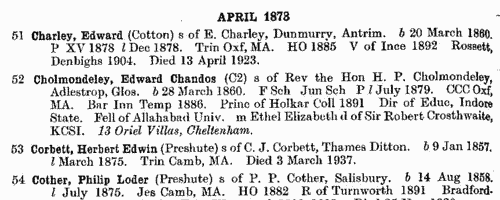
| Fellows of the British Gynaecological Society
(1891)
The alphabetical list of fellows of the British Gynaecological Society gives year of election, full name (surname first), qualifications, and address. The abbreviations used are: C., member of council; F. F., foundation fellow (i.e., since 1884); Hon. Loc. Sec., honorary local secretary; Hon. Sec., honorary secretary; H.P., honorary president; L., life fellow; Libr., librarian; Pres., president; Treas., treasurer; V.P., vice-president. | Sample scan, click to enlarge

| Boys entering Brighton College
(1893)
This edition of the Brighton College Register was published in 1922. The plan of the publication was to list boys by year or, later, term of entry. Each name is assigned a sequential number, 5000 boys, in all, being recorded. Full name is given (surname first, in bold); year of birth; year of leaving; and then (wherever the compiler had such information) a short biography, ending with date of death, where known. | Sample scan, click to enlarge
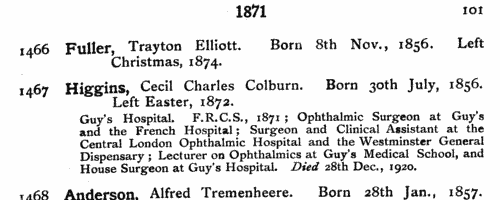
| Boys entering Haileybury College, Hertfordshire
(1893)
Haileybury College, near Hertford, was founded by the East India Company in 1806, and incorporated by Royal Charter in 1864. This register of pupils entering the school from 1862 to 1931 was edited by a master there, Laurence Arthur Speakman. The boys are listed by term of joining the school, and then alphabetically by name (in bold), surname first (in capitals). There is then usually a precise birthdate, and the name and address of his father; his period at the school, starting with abbreviations to indicate the house to which he belonged (B., Batten; B. F., Bartle Frere; C., Colvin; E., Edmonstone; Ha., Hailey; Hi., Highfield; L., Lawrence; Le B., Le Bas; M., Melvill; Th., Thomason; T., Trevelyan), and the first and last forms attended (e. g., IV., fourth form). Where a member of a school team there is then an indication (e. g., XI., cricket). For some pupils, with whom the school had lost touch, Speakman was only able to record the details of their time at Haileybury; but for most a brief career synopsis is then given, and current address (as in 1931) or date of death.
| Sample scan, click to enlarge
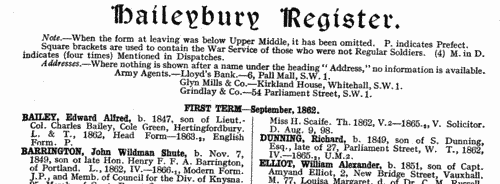
| Boys entering Harrow School
(1893)
This Second Volume of the Second Series of the Harrow School Register was edited by J. H. Stogdon and published in 1925. The boys are listed by term of entrance, and then alphabetically by surname and christian names (in bold). Next, in brackets and in italics, is the school house to which he belonged - or, H. B. indicating a day boy whose family lived in Harrow. Stogdon then gives the father's surname and initials, and address. In cases where the boy was prominent in sports at school, or won academic prizes, scholarships &c., that is given; then the year of leaving the school; a synopsis of his career; and, where known, his address as of 1925, in italics. | Sample scan, click to enlarge
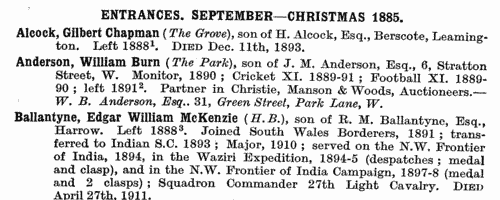
| Boys entering Manchester Grammar School
(1895)
This Biographical Register of Old Mancunians lists boys alphabetically by year of entering the school. A bare register of entrants existed from 1888 onwards but it was only since the Second World War that any kind of detailed record was kept of those who passed through the school. So, in every case in this printed register, full name is given, in bold, surname first (in capitals); date of birth, and years attending the school; but for the earlier years sometimes there is no more information - or, equally, after investigation among Old Mancunians and published sources, the editors may have been able to furnish a condensed biography. An asterisk indicates a holder of a Foundation Scholarship. In the later years a current address is also given, as of 1964 to 1965, when the book was prepared. | Sample scan, click to enlarge
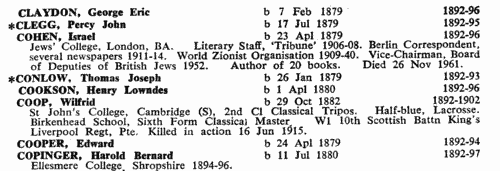
| Residents of Surrey
(1895)
Kelly's Directory of Surrey includes this alphabetical Court Directory, listing private residents in the county. In fact, this listing is a little more comprehensive than the main directory, in that it includes residents of some London suburbs that, although in the county of Surrey, are not included in the Surrey directory. Residents are listed surname first, then christian name or initials, and postal address. | Sample scan, click to enlarge

| Associates of King's College, London
(1896)
Former students of King's College, London, could be elected as associates of the college, and then enjoyed the privilege of perpetual free admission to all the classes in the department from which they had been elected; the use of the libraries and museums on the same basis as current students; and admission to dine at high table in the college hall. This list of associates from the college calendar for 1896-1897 gives year of election, full name (surname first), and the faculty or department in which graduated, of all associates elected from 1866 to 1896. | Sample scan, click to enlarge

| Boys entering Sherborne School
(1896)
The grammar school at Sherborne in Dorset, which doubtless existed from the creation of the diocese of Sherborne in 705, was refounded by king Edward VI in 1550. At the quatercentenary in 1950, a fourth edition of the Sherborne Register was published, listing boys entering the school during those four centuries. In truth, the materials for this register survive but fitfully before 1823; for some years, no names are known; sometimes all that is known is a surname. But from 1823 onwards the lists and the details get steadily more comprehensive. By the 20th century the boys are listed alphabetically by surname under term of entrance. Surname is given in bold, then christian names, name of father (surname and initials) and address; year of birth; house (a, School House; b, Abbey House; c, The Green; d, Harper House (formerly The Retreat); f, Abbeylands; g, Lyon House; h, Westcott House); whether represented the school at cricket (xi), football (xv), shooting (viii), &c.; year of leaving; summary of degrees, career &c.; and (in italics), address as of 1950. Names in the early lists marked with an asterisk are found inscribed on the oak panelling or on the stone walls of the former schoolroom. (F) in the lists indicates a foundationer, receiving free education: after 1827, when this privilege was restricted to boys from Sherborne and neighbourhood, nearly all foundationers were day-boys. | Sample scan, click to enlarge
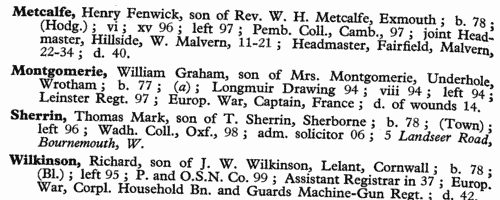
|
Research your ancestry, family history, genealogy and one-name study by direct access to original records and archives indexed by surname.
|











